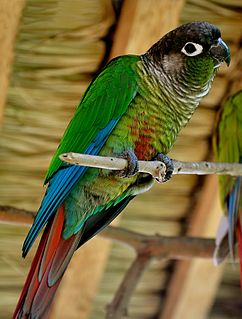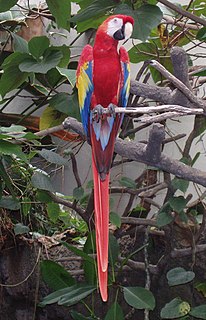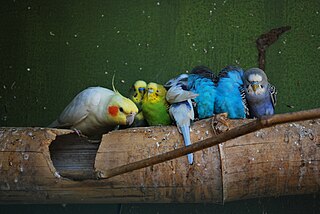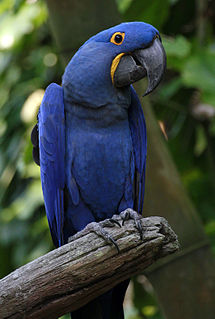Related Research Articles

Macaws are a group of New World parrots that are long-tailed and often colorful. They are popular in aviculture or as companion parrots, although there are conservation concerns about several species in the wild.

A parakeet is any one of many small to medium-sized species of parrot, in multiple genera, that generally has long tail feathers. Older spellings still sometimes encountered are paroquet or paraquet. In American English, the word parakeet usually refers to the budgerigar. The budgerigar is a species of parakeet.

Conures are a diverse, loosely defined group of small to medium-sized parrots. They belong to several genera within a long-tailed group of the New World parrot subfamily Arinae. The term "conure" is used primarily in bird keeping, though it has appeared in some scientific journals. The American Ornithologists' Union uses the generic term parakeet for all species elsewhere called conure, though Joseph Forshaw, a prominent Australian ornithologist, uses conure.

Spix's macaw, also known as the little blue macaw, is a macaw species endemic to Brazil. It is a member of tribe Arini in the subfamily Arinae, part of the family Psittacidae. It was first described by German naturalist Georg Marcgrave, when he was working in the State of Pernambuco, Brazil in 1638 and it is named for German naturalist Johann Baptist von Spix, who collected a specimen in 1819 on the bank of the Rio São Francisco in northeast Bahia in Brazil.

The green-cheeked parakeet or green-cheeked conure is a small parrot of the genus Pyrrhura, which is part of a long-tailed group of the New World parrot subfamily Arinae. The term conure is often used for this parrot and its relatives in aviculture. It is native to the forests of South America.

The scarlet macaw is a large red, yellow, and blue Central and South American parrot, a member of a large group of Neotropical parrots called macaws. It is native to humid evergreen forests of the Neotropics. Its range extends from south-eastern Mexico to Peru, Ecuador, Colombia, Bolivia, Venezuela and Brazil in lowlands of 500 m (1,600 ft) up to 1,000 m (3,300 ft), the Caribbean island of Trinidad, as well as the Pacific island of Coiba. Formerly, it ranged north to southern Tamaulipas. In some areas, it has suffered local extinction because of habitat destruction, or capture for the parrot trade, but in other areas, it remains fairly common. It is the national bird of Honduras. Like its relative the blue-and-yellow macaw, scarlet macaws are popular birds in aviculture as a result of their striking plumage.

Aviculture is the practice of keeping and breeding birds, especially of wild birds in captivity. Aviculture is generally focused on not only the raising and breeding of birds, but also on preserving avian habitat, and public awareness campaigns.

The hyacinth macaw, or hyacinthine macaw, is a parrot native to central and eastern South America. With a length of about one meter it is longer than any other species of parrot. It is the largest macaw and the largest flying parrot species; the flightless kākāpō of New Zealand outweighs it at up to 3.5 kg. While generally easily recognized, it could be confused with the smaller Lear's macaw. Habitat loss and the trapping of wild birds for the pet trade have taken a heavy toll on their population in the wild, so the species is classified as Vulnerable on the International Union for Conservation of Nature's Red List, and it is protected by its listing on Appendix I of the Convention on International Trade in Endangered Species of Wild Fauna and Flora (CITES).

The red-masked parakeet is a medium-sized parrot from Ecuador and Peru. It is popular as a pet and are better known in aviculture as the cherry-headed conure or the red-headed conure. They are also considered the best talkers of all the conures.

The blue-throated macaw, also known as the Caninde macaw or Wagler's macaw, is a macaw endemic to a small area of north-central Bolivia, known as Los Llanos de Moxos. In 2014 this species was designated by law as a natural patrimony of Bolivia, where it is known as barba azul, which means 'blue beard' in Spanish. Until 2010, it was hunted by natives to make feathered "Moxeño" headdresses for "machetero" ritual dances.

A bird hybrid is a bird that has two different species as parents. The resulting bird can present with any combination of characters from the parent species, from totally identical to completely different. Usually, the bird hybrid shows intermediate characteristics between the two species. A "successful" hybrid is one demonstrated to produce fertile offspring. According to the most recent estimates, about 16% of all wild bird species have been known to hybridize with one another; this number increases to 22% when captive hybrids are taken into account. Several bird species hybridize with multiple other species. For example, the mallard is known to interbreed with at least 40 different species. The ecological and evolutionary consequences of multispecies hybridization remain to be determined.

The golden parakeet or golden conure,, is a medium-sized golden-yellow Neotropical parrot native to the Amazon Basin of interior northern Brazil.

A feral parrot is a parrot that has adapted to life in an ecosystem to which it is not native. The birds are often descended from pets that have escaped or been deliberately released. Many species of parrots are highly social, and like to gather in large flocks. Not all feral parrots are able to adapt to life outside of captivity, although having a pre-existing nearby parrot colony can assist with the adaptation process.

The jandaya parakeet or jenday conure is a small Neotropical parrot with green wings and tail, reddish-orange body, yellow head and neck, orange cheeks, and black bill, native to wooded habitats in northeastern Brazil. It is a member of the Aratinga solstitialis complex of parakeets very closely related to, and possibly subspecies of the sun parakeet.
Tony Silva is an American aviculturist and ornithologist, and the author of books and articles about parrots. From 1989 to 1992, he was curator of birds at Loro Parque, the largest parrot park in the world. In 1996, he was convicted of conspiring to smuggle rare parrots into the United States and of tax evasion.

The Funds for Endangered Parrots (FbP) is a German non-governmental organisation (NGO) in the field of species conservation, which supports and operates projects worldwide for endangered parrot species.
Birds International Incorporated or BII is a company working in the field of aviculture established in 1975 by Antonio de Dios. It is located in Quezon City near Manila, the capital of the Philippines.
Antonio de Dios is a "bird aficionado" known in the relevant circles from the Philippines who established in 1975 Birds International, Inc., a company working in the field of aviculture.

The Macaw Society is a long-term research project on the ecology and conservation of macaws and parrots under the direction of Donald Brightsmith and Gabriela Vigo of the Schubot Center for Avian Health at the Texas A&M University. The project has been working with wildlife and local communities since 1989. The long-term research and monitoring have provided many insights into various aspects of parrot and wildlife of south-eastern Peru. Macaws are among the most effective flagship species for ecosystem conservation in the Amazonian rainforest.

The Catalina macaw, sometimes known as the rainbow macaw is a first generation hybrid between the blue-and-gold macaw and scarlet macaw. As catalina macaws are hybrids, they do not have a true scientific name. The best way to represent these birds in taxonomy is by the expression Ara ararauna × Ara macao.
References
- ↑ "AFA History". AFA Website. Archived from the original on October 16, 2013. Retrieved Oct 14, 2013.
- ↑ "AFA History". AFA Website. Archived from the original on October 16, 2013. Retrieved Oct 14, 2013.
- ↑ "AFA History". AFA Website. Archived from the original on October 16, 2013. Retrieved Oct 14, 2013.
- ↑ "AFA Mission". AFA Website. Archived from the original on January 26, 2021. Retrieved March 20, 2021.
- ↑ "AFA Regional Map". AFA Website. Archived from the original on October 16, 2013. Retrieved Oct 14, 2013.
- ↑ "AFA Annual Convention". AFA Website. Archived from the original on October 16, 2013. Retrieved Oct 14, 2013.
- ↑ "AFA Watchbird". AFA Website. Archived from the original on October 16, 2013. Retrieved Oct 14, 2013.
- ↑ "AFA FOA". AFA Website. Archived from the original on October 16, 2013. Retrieved Oct 14, 2013.
- ↑ Brugger, Rachael. "AFA Releases Online Certification Course". BirdChannel.com. Retrieved Oct 14, 2013.
- ↑ "AFA Conservation Projects". AFA Website. Archived from the original on October 16, 2013. Retrieved Oct 14, 2013.
- ↑ "AFA Grant Submission". AFA Website. Archived from the original on October 16, 2013. Retrieved Oct 14, 2013.
- ↑ "Congress to Consider Ban on Exotic Pets". Veterinary Practice News. Retrieved Oct 14, 2013.